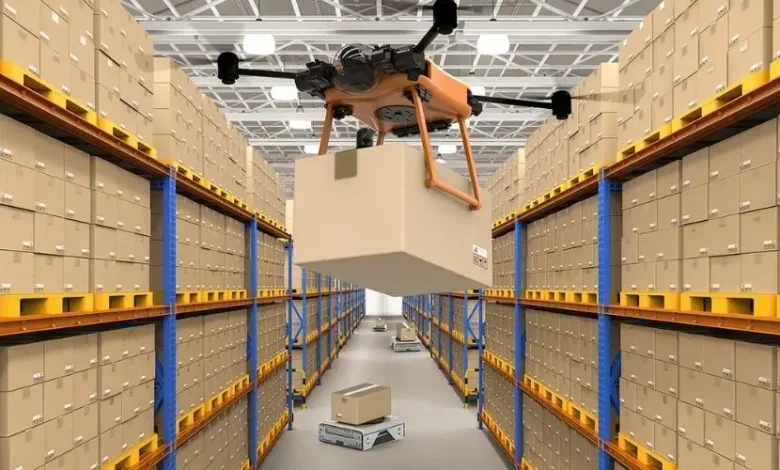The Role of Robotics in Streamlining Warehouse Management Processes

Introduction to warehouse management and automation;
Warehouse management is an intricate dance of logistics, inventory control, and supply chain efficiency. In today’s fast-paced world, the stakes are higher than ever. Companies are constantly seeking ways to optimize their operations and reduce costs while meeting customer demands. Enter robotics—a game changer in warehouse management. The emergence of automation technologies has revolutionized how warehouses operate. From simple tasks like sorting items to complex processes such as inventory tracking, robotics enhances productivity and accuracy across the board.
As businesses strive for greater efficiency, understanding the role of robotics becomes essential. It’s not just about keeping up with competitors; it’s about staying ahead in a rapidly evolving landscape where technology reigns supreme. Let’s dive into how robotics is transforming warehouse management processes and what that means for your business’s future success.
The evolution of robotics in warehouse management;
Robotics has dramatically transformed warehouse management over the years. In the early days, manual labour was the backbone of operations. Workers relied on sheer effort to move goods and manage inventories. As technology advanced, forklifts and conveyor belts became commonplace. These tools increased efficiency but still required human oversight. The introduction of automated guided vehicles (AGVs) marked a significant turning point. They navigated through warehouses without direct human control, optimizing movement patterns.
Today, we witness sophisticated robots that employ artificial intelligence for better decision-making. These machines can identify items, sort products, and even collaborate with humans in real time. This evolution reflects a broader trend towards smarter systems that enhance productivity while reducing errors and costs. As robotics continues to advance, its role in warehouse management becomes increasingly vital.
Benefits of incorporating robotics in warehouse automation processes;
Incorporating robotics into warehouse automation offers a myriad of advantages. First and foremost, efficiency skyrockets. Robots can perform repetitive tasks faster than human workers, reducing the time it takes to pick, pack, and ship products.
1. Increased efficiency and productivity: One of the main benefits of using robotics in warehouse management processes is the significant increase in efficiency and productivity. Robots can perform tasks at a much faster rate than humans, allowing for a quicker turnaround time in receiving, sorting, and shipping goods. This not only saves time but also reduces labour costs as fewer human workers are needed to complete these tasks.
2. Improved accuracy and reduced errors: With the use of advanced sensors and programming, robots have a high level of precision when it comes to performing repetitive tasks such as picking and packing. This results in reduced errors and improved accuracy, leading to better inventory management. By minimizing human error, businesses can avoid costly mistakes that can occur during manual processes.
3. Enhanced safety: Warehouses can often be hazardous environments for workers due to heavy machinery and equipment moving around constantly. By incorporating robots into warehouse management processes, businesses can reduce the risk of accidents or injuries caused by manual handling of heavy objects or operating dangerous machinery.
4. Flexibility: Robotics technology allows for customization based on business needs. As warehouses handle various types of products, robots can be programmed to handle different sizes, shapes, weights, and materials with ease. This level of flexibility enables them to adapt quickly to changing demands without any additional training or physical modifications.
5. Cost savings: While the initial investment cost may seem steep for implementing robotics in warehouse management processes, it ultimately leads to long-term cost savings due to increased efficiency and productivity levels mentioned earlier. Additionally, by automating certain tasks previously done manually by employees, businesses can allocate their workforce towards more value-added activities such as managing inventory levels or analyzing data for better decision-making.
6. Real-time tracking and monitoring: With the use of robotic technology in warehouses comes real-time tracking capabilities that provide accurate data on inventory levels and movement within the facility at any given moment. This enables businesses to make informed decisions and respond quickly to any changes in demand or supply.
Challenges and limitations of using robotics in warehouse management;
Implementing robotics in warehouse management is not without its hurdles. One significant challenge is the initial investment cost. Advanced robotic systems can be expensive, creating a barrier for smaller businesses. Integration poses another issue. Existing infrastructure may need upgrades to accommodate new technology, leading to potential downtime and disruption during the transition period.
Additionally, workforce concerns arise. Employees may worry about job security as robots take over repetitive tasks. This can create resistance among staff who feel threatened by automation. Maintenance and technical support are crucial too. Robotics require regular upkeep and skilled technicians for repairs or troubleshooting, which adds ongoing costs.
Future trends and advancements in warehouse automation technology;
The future of warehouse automation is set to transform the industry dramatically. Emerging technologies like artificial intelligence and machine learning will enhance robotic capabilities. Robots will not only perform repetitive tasks but also learn from their environment, adapting in real time.
Collaborative robots, or cobots, are gaining traction too. These machines work alongside human workers, increasing efficiency without compromising safety. This synergy allows for a more dynamic workflow where humans can focus on complex problem-solving. Moreover, advancements in sensor technology and IoT integration are creating smarter warehouses. Real-time data collection enables predictive maintenance and inventory management with unprecedented accuracy.
Lastly, autonomous vehicles for material transport promise reduced labour costs and faster operations. As these innovations continue to unfold, warehouses will become increasingly agile environments capable of meeting ever-changing consumer demands seamlessly.
How to choose the right robotics solution for your warehouse?
Selecting the right robotics solution for your warehouse starts with understanding your specific needs. Assess the tasks you want to automate. Is it picking, packing, or inventory management? Each function may require a different type of robot.
- Choosing the right robotics solution for your warehouse can be a daunting task. With so many options available in the market, it can be overwhelming to determine which one would best suit your specific needs and requirements. However, with proper research and understanding of your warehouse operations, you can make an informed decision that will ultimately help streamline your warehouse management processes.
- The first step in choosing the right robotics solution is to evaluate your current warehouse processes. This includes identifying areas where there may be bottlenecks or inefficiencies that could benefit from automation. It is important to involve all key stakeholders in this process, including warehouse managers, operators, and IT personnel. They will have valuable insights into the daily operations and can provide valuable feedback on pain points and areas for improvement.
- Next, consider what tasks or processes you want to automate with robotics. Some common applications of robotics in warehousing include picking and packing, palletizing and depalletizing, sorting and counting, inventory management, and transportation of goods within the warehouse. By identifying which tasks are most critical to your operations and can benefit from automation, you can narrow down the types of robotics solutions that would be most suitable for your warehouse.
- Another crucial factor to consider when choosing a robotics solution is its compatibility with your existing systems. The last thing you want is for a new system to disrupt or cause complications with your current software or hardware infrastructure. Therefore, it is essential to carefully assess how the new robotics system will integrate with your existing systems before making a decision.
- When evaluating different robotics solutions, it is also important to consider their flexibility and adaptability. As technology continues to advance rapidly in the warehousing industry, you want a solution that can easily adapt to future changes without requiring significant investments or disruptions in operations. Look for systems that offer customization options and can scale up as your business grows.
Conclusion:
Embracing technology is no longer a choice but a necessity in today’s fast-paced logistics environment. Warehouse management processes are complex and often require innovative efficiency solutions. Robotics provides that edge.
As operations evolve, the integration of robotics can lead to significant improvements in productivity. Automated systems can optimize inventory handling, reduce human error, and enhance overall safety within the warehouse setting. The ability to adapt quickly to changing demands makes robotics an invaluable asset.
The journey toward automation may come with its challenges, yet the rewards are undeniable. Companies willing to invest in these technologies position themselves ahead of their competitors while enhancing customer satisfaction through faster response times.
With advancements on the horizon and new solutions continually emerging, now is the time for businesses to explore how robotics can transform their warehouse operations.







